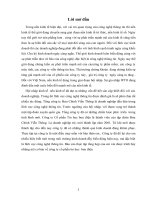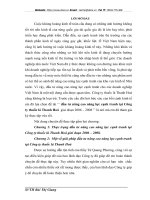Split estate presentation 2006
Bạn đang xem bản rút gọn của tài liệu. Xem và tải ngay bản đầy đủ của tài liệu tại đây (3.43 MB, 34 trang )
Split Estate
Private Surface / Public Minerals
What Does it Mean to You?
2006
Overview of Presentation
• Why Were the Surface and Mineral
Estates, Split?
• Energy Policy Act of 2005, Section
1835 and a Report to Congress – Our
Task
• How BLM Manages Split Estate
• How To Reduce the Impact of Energy
Development on Private Surface
Where Is Oil
and Gas
Found
in the Western
United States?
Green and Red areas
on the map show
Oil and Gas production
areas.
Private
Federal
State
Federal
State
Private
This Presentation
Private
Private
Federal
State
Federal
Federal
Private
State
How did the surface
estate become
separated from the
mineral estate?
Private Surface
Public Minerals
After the Revolutionary War, the Continental
Congress began the process of selling lands
in order to help repay the war debt.
Eventually a cry went out for “FREE LAND” that
could be obtained through sweat equity.
The Country also saw the need for a way to
encourage settlement of the West.
FREE LAND!
FREE LAND!
1862
160 Acres
Over time, Congress responded with 3 main
Homestead Acts to encourage settlement of the West.
In 1862 the Original Homestead Act was passed.
It provided a gift of 160 acres if you lived on the land
for 5 yrs; cultivated it; and constructed at least a
12'X14‘ building on it. You also received the minerals!
1909
320 Acres
37 years later in 1909 Congress passed The Enlarged
Homestead Act. Since the prime river bottoms had
largely been claimed under the previous act,
homesteaders began looking for land they could dryland
farm. Since this land was generally less productive than
river bottom acreage, homesteaders were given 320
acres under this act.
1910
Congress Recognizes
Different Values
Surface = agriculture
Subsurface = minerals
As early as 1910 Congress recognized that some
Federal lands had surface that was valuable for
agriculture and subsurface that was desired for mineral
extraction, so……
The Government began selling the surface, and either
retaining the minerals, or selling them to someone else.
1914
During the early homesteading days the Fed govt didn't
retain the minerals, or it retained only the coal (i.e.. the
Homestead Act or the Enlarged Homestead Act).
However, concern grew that strategic minerals needed
to fuel the economy were being locked up by a
relatively few people. So in 1914 Congress began
retaining most of the mineral estate under acts like the
Stockraising Homestead Act of 1916.
1916
640 Acres
Stock Raising Homestead Act
For Ranching Purposes
In 1916 The Stock Raising Homestead Act was
passed. It provided settlers 640 acres of prairie
for ranching purposes. Under this act, the
minerals were reserved to the Fed Govt.
Bureau of Land Management (BLM)
Administers Surface and Minerals
for the Federal Government
261 Million Surface Acres
----------------------------------------------------------------------------------------------------------------------------------------------------------------
700 Million Mineral Acres
58 Million Acres
NonFederal Surface
Federal Minerals
Energy Policy
Act
Energy
Policy
Of Act
2005 of 2005
The Energy Policy Act was signed by the President in
August of 2005. The focus of the Act is securing
reliable, affordable supplies of energy for American
homes and businesses.
Energy Policy Act of 2005
Sec 1835
Split Estate
► In consultation with private surface
owners, industry and interested parties,
the Secretary shall review current policies
and practices of management of Federal
subsurface oil and gas activities and their
effects on private surface ownership.
Affected Party Consultation
• Meeting with Local BLM Managers
• Listening Sessions
– Public Comments to a Panel
• E-mail Comments:
– Were Due April 1:
• Report to Congress
• Further Information:
– Website: www.blm.gov/bmp
BLM Conducted Split Estate
Listening Sessions &
Accepted E-mail Comments
New Mexico
Colorado
9 listening sessions
were held at 5 locations
across the West and
Washington DC
Wyoming
Montana
Washington, D.C.
State/Date
Speakers
Albuquerque, NM
March 20, 2006
1:00 PM
7:00 PM
25
7
1:00 PM
7:00 PM
100+
64
Grand Junction, CO
March 22, 2006
1:00 PM
7:00 PM
12
7
1:00 PM
7:00 PM
43
22
Casper, WO
March 24, 2006
1:00 PM
7:00 PM
32
7
1:00 PM
7:00 PM
72
20
Miles City, MT
March 27, 2006
1:00 PM
7:00 PM
6
2
1:00 PM
7:00PM
20
6
Washington, DC
March 31, 2006
1:00 PM
4
1:00 PM
10
Total
Participants
102
360+
In addition to the National listening sessions, our
doors are always open at the State Office, District
Local
Listening
Opportunities
Office, and Field Office level to discuss local
problems and find local solutions.
Our Doors Are Always Open
BLM produces a brochure that helps explain
the Rights, Responsibilities, and
Opportunities of the BLM, Operator, and
Surface Owner. Contact your local BLM
office to obtain a copy.
Split Estate
Rights, Responsibilities, and Opportunities
How Does the BLM Manage
Oil and Gas Development
in Split Estate Situations?
• Land Use Planning
– The BLM Resource Management Plan is the
Foundation for Oil and Gas Decisions on Split Estate.
• Open or Closed to Leasing
• Lease stipulations
– BLM routinely updates its land use plans.
– BLM strongly encourages public involvement during
the Resource Management Plan process.
– State and Local Governments may be Cooperating
Agencies.
How Does the BLM Manage
Oil and Gas Development
in Split Estate Situations?
• Lease Sales
– BLM provides a minimum of a 45-day public
notification prior to leasing
– BLM is looking at ways to better notify the
public prior to leasing.
How Does the BLM Manage
Oil and Gas Development
in Split Estate Situations?
• The Onsite Meeting
– The surface owner
is invited to attend
and identify
development
preferences.
Current BLM Policy
►BLM Requires that the Operator engage the
Surface Owner in negotiations for the
purpose of obtaining a surface use
agreement:
1. Surface owner agreement for access, or
2. Waiver from surface owner for access, or
3. Agreement regarding compensation
Current BLM Policy
• Surface Use/Access Agreement
– BLM requires the lessee/operator to make a
good faith effort to obtain an agreement with
the surface owner.
– Failing that, the operator can “bond-on”
– Bonding-on is a very rare occurrence.









